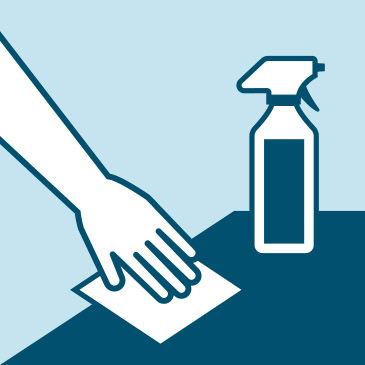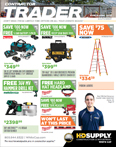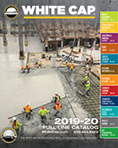Disinfecting Your Jobsite To Protect Workers
What Contractors Need to Know About Disinfecting Tools, Equipment, and Jobsites
Disinfecting has become a standard practice on our jobsites as the pandemic continues to redefine our New Normal. Contractors, whose jobsite health and safety focus was on housekeeping, are now adding new disinfecting procedures.
Cleaning Versus Disinfecting
 Normal cleaning solutions such as soaps are not 100 percent effective in removing viruses. Workers should pre-clean surfaces when visibly dirty using a mild soap and clean damp cloths. Following this prep, disinfecting agents complete the cleansing process. The Centers for Disease Control and Prevention (CDC) has some great general tips on disinfecting.
Normal cleaning solutions such as soaps are not 100 percent effective in removing viruses. Workers should pre-clean surfaces when visibly dirty using a mild soap and clean damp cloths. Following this prep, disinfecting agents complete the cleansing process. The Centers for Disease Control and Prevention (CDC) has some great general tips on disinfecting.
It’s Important To Use Registered Products
Regardless of the method used to disinfect your jobsite , the process starts with choosing the right products. It’s always best to select from a trusted vendor. If supplies are running short, exercise caution when purchasing. It’s always a good idea to verify a product’s compatibility with the equipment you’ll be using. Also check the product’s date of effectiveness, as some disinfectants have a relatively short shelf-life.
The FDA urges consumers to verify that products are properly registered.
During the initial stages of the response to the pandemic, the U.S. Food and Drug Administration (FDA) relaxed their adoption procedures and registered more than 1,500 additional manufacturers offering new hand sanitizer products. While most of these new products are effective, some have been found to be unsafe or touting unproven results.
What Is The EPAs “List N”?
The U.S. Environmental Protection Agency (EPA) continues its commitment to increasing the availability of surface disinfectants for use against SARS-CoV-2, the novel coronavirus that causes COVID-19. The EPA’s “List N” contains disinfectants for use against SARS-CoV-2. This list now contains over 360 products and has enhanced functionality to allow users to sort these products by surface type and use site. EPA is also continuing to expedite the review process for new disinfectants.
Contractors can checkout the EPA’s “List-N” for all approved disinfectants that meet the criteria for use against SARS-CoV-2 (the new coronavirus) .
Check The EPA’s “List-N” Here
How To Tell If A Product Is Registered
To determine if a product is included on List N, check its EPA registration number (EPA Reg. No.). If it is, you have a match and the product can be used against SARS-CoV-2. You can find the registration number on the product label – just look for “EPA Reg. No.” followed by two or three sets of numbers. For example, if EPA Reg. No. 12345-12 is on List N, you can buy EPA Reg. No. 12345-12-2567 and know you’re getting an equivalent product. Follow the contact time provided on List N.
Please be aware that products may be marketed and sold under different brand names, but if they have the same EPA registration number, they are related products. Some products EPA calls “supplemental distributor products” have EPA registration numbers that contain three sets of numbers. If the first two sets of numbers match a registration number that is on List N, the product is the equivalent to the listed product.
To obtain a registration, a manufacturer must submit specific data about the safety and effectiveness of each product. For example, EPA requires manufacturers of sanitizers, disinfectants, or chemical sterilants to test formulations by using accepted methods for microbiocidal activity, stability, and toxicity to animals and humans. – The CDC
For more info on how products are registered, go here:
Regulatory Framework | Disinfection & Sterilization Guidelines | Guidelines Library | Infection Control | CDC
Guideline for Disinfection and Sterilization in Healthcare Facilities (2008) Before using the guidance provided in this document, health-care workers should be aware of the federal laws and regulations that govern the sale, distribution, and use of disinfectants and sterilants. In particular, health-care workers need to know what requirements pertain to them when they apply these products.
Outside Versus Inside
According to the CDC, outdoor areas should not normally require disinfections. Contractors should continue normal outdoor housekeeping and cleaning procedures. But experts do suggest disinfecting outdoor hard surfaces and objects frequently touched by multiple workers. These touch points include tools, equipment handles, and tables. Workers can use alcohol-based wipes before and after use to disinfect the surface.
Interior work areas may require additional procedures. Contractors are adopting new procedures to disinfect vehicle interiors, tools, equipment, shared interior work areas, and even completed projects prior to turnover.
What To Do With Your Equipment
Shared equipment presents new challenges for workers. The CDC has provided guidance on cleaning. At a minimum, clean and disinfect commonly touched surfaces in your vehicles at the beginning and end of each shift. These areas include all machine touchpoints: dipstick, gas cap, engine access points, handles, latches, and floorboards, etc. Always check/adhere to the owner’s manual/manufacturer’s guidelines on proper usage.
Many contractors are placing bottles of sanitizer at ground level of movable equipment so operators and drivers can spray all door handles and grab bars as they enter and disembark from the cab. The CDC recommends disinfecting vehicles and heavy machinery once each shift, as well as before or after each operator use.
Four Disinfecting Methods and Applications
1. Contact Surfaces And Small Areas
Many contractors are using presaturated wipes to disinfect small surfaces such as shared tools. Select products that are cost-effective and efficient. Qualities to consider include tear resistance (opting for strong synthetic fabrics); abrasion resistance (choosing knitted or non-woven wipes); and size (the best practice is to use one wipe for each surface area to avoid cross contamination).
For larger touchpoint area cleaning, opt for a sprayer designed for disinfectants. With a 1-Gal. funnel-top and ergonomic design, units like Chapin’s 20075 bleach sprayer are perfect for disinfecting larger areas on the jobsite.
2. Airless Sprayers
Airless sprayers, like Titan’s Impact 440 (see video), are proven to spray select solutions from the EPA’s “List N” to apply disinfectant to surfaces contaminated by the novel coronavirus which causes COVID-19. Airless sprayers provide high production rates allowing Remediation/Disinfectant contractors to get jobs done faster with better coverage.
Using High Efficiency Airless (HEA) spraying tips optimizes disinfecting. HEA tips deliver a consistent wetted surface without over-saturation with bigger droplets set anywhere from 500 – 1200 PSI. The Titan HEA tip can decrease overspray up to 55%. These tips can be used for a wide range of N-Listed products, including alcohol and water-based disinfectants.
Airless sprayers with HEA tips can atomize disinfectant solutions at relatively low pressure (as little as 500 psi). Similar to misters and handheld spray application machines, the average atomized droplet size is about 30 microns, and they do not produce large overspray clouds.
Larger particles don’t “hang” in the air indefinitely and will settle on to the surface to help create the proper “wet” time”
3. Fogging
Many jobsites aren’t completely enclosed. Some areas of a site may be exposed to ambient conditions such as wind and temperature, which can greatly affect disinfecting procedures. In these environments, fogging equipment can effectively disinfect shared work areas. Unlike enclosed work areas, to properly coat surfaces with disinfectants, foggers must have elevated levels of power and air flow to effectively apply chemical solutions. Opt for foggers that can provide droplet sizes 100 microns or better to eliminate spray loss. Consider units like the Tomahawk TMD14 Backpack Fogger that generates 475 CFM of air flow, which helps transport disinfectants directly to the desired surface.
4. Electrostatic Disinfecting (Transmission Mitigation Equipment)
When worksites require close worker contact in enclosed settings, contractors may elect to use electrostatic disinfection. These units produce and atomized spray with negatively charged particles that aggressively adhere to surfaces and objects. This application is perfect for sanitizing awkwardly shaped objects or hard to reach places commonly found on MEP projects.
NOTE:
The product that is being sprayed needs to be negatively charged (this is important to avoid any issues and to ensure it works properly).
At first look this approach may look like overkill, but multiple manufacturers report that disinfecting time is reduced up to 75 percent compared to conventional methods. For contractors with critical timing this process can be a game changer. Another advantage is that surfaces already covered will repel the spray, reducing disinfectant waste. So the time and materials saved can outweigh the higher price tag.
![]()
Tips For Disinfecting Your Equipment
https://www.whitecap.com/covid-19-resources#Tips-for-Disinfecting-your-Equipment





NOTE: